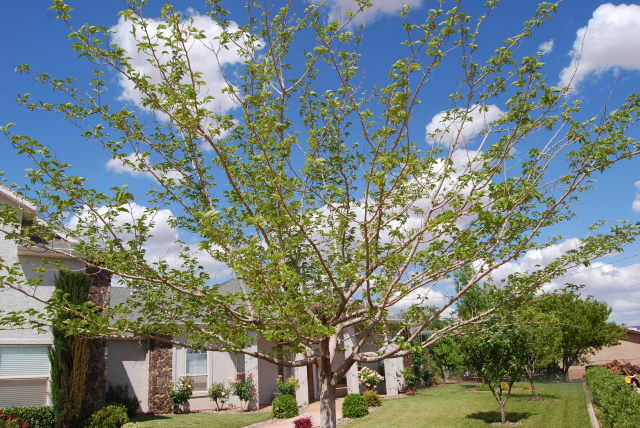Question
 Fruitless Mulberry
Fruitless Mulberry
I have a fruitless mulberry. About 2 years ago it stopped growing. It goes into dormancy earlier and come out later than all the other mulberries in the neighborhood. Even to date the leaves are about half size of other mulberries in the area. I live in St. George, UT, where mulberry trees grow like weeds. I've tried a PH something or other to break down the alkali in the soil. It is in my front lawn. Soil was fairly sandy but deeper down in parts of my back yard I have come across some indications of clay.
AnswerHi Brent,
Thanx for your question. I'm really not a tree expert like Jim Hyland who is over on our Trees forum but I will go ahead and give you what I know and then you can check with Jim for his expertise.
This tree is a fast grower so it has high water requirements. You live in an area that naturally gets little rainfall. The tree will require frequent deep watering. That means about once a week you'll need to ensure the tree's roots are soaked with water. You can bury a soaker hose around the tree and then run it for a couple of hours a week. You would also need to ensure that herbicides are not being ingested by the tree. If you are using Roundup or something like that in the same proximity, the tree's roots may be absorbing it (although Roundup biodegardes in 24 hours)which would stunt growth. If you had a very cold winter, that will bring the tree into a deep dormancy and cause the tree to come out of that dormancy slower than normal. Make sure the tree has plenty of organic materials incorporated into the soil around it and you can use fertilzer sticks too. The only other thing I would do is consult with my local County Extension Agent to see if the State of Utah has any information regarding growth problems with fruitless Mulberry. Contact the Utah State University Extension Service Office in St. George.
Washington County
44 N. 100 E.
St. George, UT 84770
435-634-5706
http://extension.usu.edu/washington
I hope this helps.
Tom






